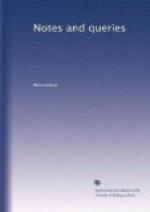* * * * *
REPLIES.
THE DODO.
Mr. Strickland has justly observed that this subject “belongs rather to human history than to pure zoology.” Though I have not seen Mr. Strickland’s book, I venture to offer him a few suggestions, not as answers to his questions, but as slight aids towards the resolution of some of them.
Qu. 1. There can be no doubt about the discovery of Mauritius and Bourbon by the Portuguese; and if not by a Mascarhenas, that the islands were first so named in honour of some member of that illustrious family, many of whom make a conspicuous figure in the Decads of the Portuguese Livy. I expected to have found some notice of the discovery in the very curious little volume of Antonio Galvao, printed in 1563, under the following title:—Tratado dos Descobrimentos Antigos, e Modernos feitos ate a Era de 1550; but I merely find a vague notice of several nameless islands—“alguma Ilheta sem gente: onde diz que tomarao agoa e lenha”—and that, in 1517, Jorge Mascarenhas was despatched by sea to the coast of China. This is the more provoking, as, in general, Galvao is very circumstantial about the discoveries of his countrymen.
Qu. 5. The article in Ree’s Cyclopaedia is a pretty specimen of the manner in which such things are sometimes concocted, as the following extracts will show:—
“Of Bats they have as big as Hennes about Java and the neighbor islands. Clusius bought one of the Hollanders, which they brought from the Island of Swannes (Ilha do Cisne), newly styled by them Maurice Island. It was about a foot from head to taile, above a foot about; the wings one and twenty inches long, nine broad; the claw, whereby it hung on the trees, was two inches,” &c. “Here also they found a Fowle, which they called Walgh-vogel, of the bigness of a Swanne, and most deformed shape.” (Purchas his Pilgrimage, 1616, p. 642.)
And afterward, speaking of the island of Madura, he says,—
“In these partes are
Battes as big as Hennes, which the people
roast and eat.”
In the Lettres edifiantes (edit. 1781, t. xiii. p. 302.) is a letter from Pere Brown to Madame de Benamont concerning the Isle of Bourbon, which he calls “l’Isle de Mascarin” erroneously saying it was discovered by the Dutch about sixty years since. (The letter is supposed to have been written about the commencement of the eighteenth century.) He then relates how it was peopled by French fugitives from Madagascar, when the massacre there took place on account of the conduct of the French king and his court. In describing its production, he says,—




